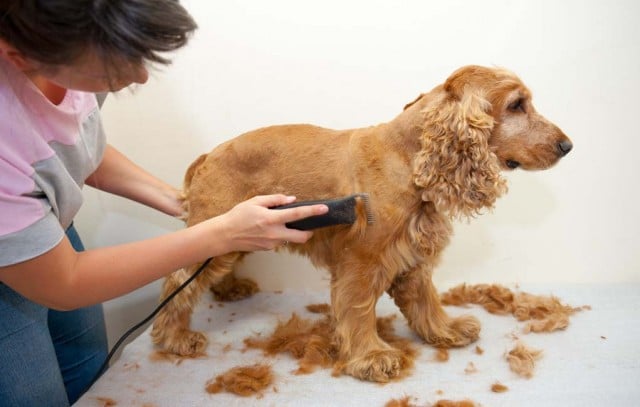
Table of Contents
One of the most common misconceptions about dog grooming is that using pet hair clippers on a canine is simple. A good pet groomer may make it look easy, but there is actually a lot you need to know about grooming your dog using dog hair clippers. For one thing, there are different styles of dog clipper blades to ensure a proper cut, and how you use them also depends on the breed of dog you have.
Understanding the different types of dog clipper blades and how to use them properly will help you become a more efficient groomer, especially if you choose to groom your dog at home, at least on a weekly basis.
If you only have one dog, or you have multiple dogs of the same breed, you may only want to use the type of clippers required for that type of coat. However, if you have multiple dogs with different coat types or you groom other dogs, you'll need to have a well-rounded knowledge of all the different types of clipper blades.
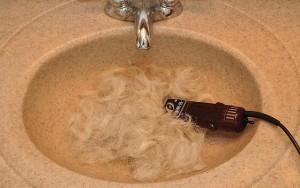
Depending on your dog's coat length and type, you'll have to select a set of pet hair clippers that meets your needs.
All dog clipper blades have two parts. The larger bottom blade is called the comb, and it feeds the hair into the top, or cutting, blade. The cutting blade moves back and forth very quickly to cut the hair with the help of the clipper motor.
The noise of the motor bothers some dogs. If your dog is scared of strange noises or nervous about grooming in general, you may want to buy silent dog clippers. In this article, you're going to learn the proper techniques to use when grooming a dog with clippers. I'll also share some tricks I've picked up while working in the pet grooming industry.
RELATED: Grooming Different Types of Dog Coats
Tricks and Techniques for Using Dog Clipper Blades
No matter what kind of coat your dog has there are certain techniques that are crucial to getting the proper cut. If you don't follow these grooming techniques, you could risk pulling and tugging on the fur, which will cause your dog a lot of unnecessary pain. You could also do permanent damage to your pet's coat.
Going With the Grain
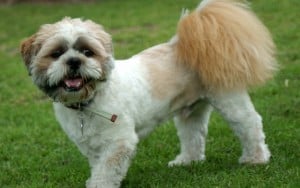
If you're going to shave your dog down but still want a little fur left over, then you're going to have to go with the grain. This means that you are not shaving in the direction where the fur is growing but shaving on the flow of the fur.
This is the most traditional grooming technique when shaving shih tzus, for example, as well as west highland terriers. In fact, this is typically the type of shave that all terriers and small dogs get when they go to the groomer or when they are shaved at home.
When you go with the grain, you shave down the dog's back in the direction of where the hair is growing. Wherever you are shaving, you have to pay attention to the direction where the fur is growing from and where the fur grows. Once you know this, you can shave off that fur while still going in the same general direction. For example, when it comes to shaving the legs, you would shave downwards instead of upwards.
Using this type of method to shave a dog down leaves enough hair behind for the dog to still have more than enough fur. It's also what most dogs get during spring or fall until they can be shaved completely down in the summertime to fight off overheating.
RELATED: Fluff Your Pup – Vital Pet Grooming Tools for the Job
Going Against the Grain
Going against the grain means that you're shaving against where the hair is growing, so the dog can be completely shaved. If you are choosing to go with this method when using a dog clipper blade, then you don't have to pay attention to where the hair is growing from and where it's going. This type of method is done during summertime when it's hot, as previously stated. It's probably the only time that your dog will love the results of using those noisy dog clippers on him or her.
When you shave against the grain, you don't really have to watch that you don't shave too much off because that's exactly what you're doing. This type of grooming is most popular with long-haired small dogs. Just remember that if your dog has a double coat (popular with breeds like Labrador retrievers) you cannot shave them or you will risk doing permanent damage to their undercoat.
Shaving the Paws
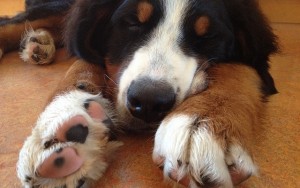
This is a grooming technique that a lot of owners who groom their own dogs don't really do, but it can be just as important as doing other general grooming. However, you must be extremely careful while working around your dog's paws. Shaving the paws with a dog clipper blade does not mean you are shaving the top of the paw, but you are shaving in the small space between the pads of a dog's paw.
When doing so, ensure that you have a good handle on the dog's paw, especially if it's his first time having this done. It's better to do this while the dog is comfortable, relaxed, and lying down. You may also want to have a second person to help hold the dog the first few times you shave his paws. This will prevent injury to either of you, and it will make the dog feel more comfortable as well.
Take the dog's paw in your hand, with the dog clipper blade in the other, and spread the paw using your index finger and your thumb. The area you're going to need to spread is just on the outside of the paw. With the clipper blade, use a scooping motion as you take the blade to the small space in between the pads of the paw. Ensure that you do not clip the pads, and take as much time as you need to.
You absolutely have to make sure that you do not clip the pads on the paw, as this will hurt your dog. Having him relax completely before you do this is the best way to go about it. If your dog does not have long hair sprouting out in that space, then you don't need to shave his paws.
RELATED: Pet Hair Clippers for Dogs – Quick Buying Guide
Getting That Finished Look
When I took my animal grooming courses, we used three different types of pet hair clipper blades for all of our clippers. We used a 10, a 15, and an F10. I used a 15-dog clipper blade on the canine's bodies and legs and used the 10-clipper blade to shave the area in between the pads of the dog's paws.
An F10 is a finishing blade that is used after you have shaved the dog down and want to make a couple of finishing touches. It's a finer blade, and it helps to neaten everything up after the rest of the shaving is done. Typically, an F10 is used on show dogs for their facial areas. It can also help blend and transition the area between long and short hair, like the base of the neck, where the short cut of the body meets the longer hair left on the head.
When using an F10 blade for a finishing look, go over any mistakes you may have made while shaving, this can happen when you go with the grain and go against it by accident, to neaten it all up. These blades are also great for the leg and paw areas, on top of the paw and not the bottom, to help neaten the look a bit more.
RELATED: How to Start a Dog Grooming Business
Using Dog Grooming Shears
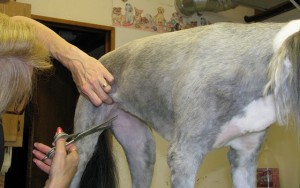
If you're someone who wants to know how to use grooming shears like a professional, then I've got all the answers. Grooming shears are long scissors, something you'd see at a barber's, for example, and are extremely easy to use.
Take your thumb and your index finger, put them into the holes, and loosen your hand up. You should be able to feel the scissors move freely in your hand. This is the best way to use them because when you're cutting the fur, the scissors will glide around and give it a neat and airy cut.
Make sure to take your time when using grooming shears. They need to be very sharp to easily cut through the hair, and that means that one quick slip could very easily injure you or your pet. Go slowly, think about where you want to cut, and then quickly snip the excess hair.
Grooming Your Dog the Right Way
You may make a couple of mistakes the first few times you learn to use grooming equipment with your dog, but that's okay. Trial and error is the key. Before you know it, you'll only need the help of a professional groomer for major issues because you'll be able to do all the regular grooming yourself.
If you're more of a visual learner, you can look online for videos of professional groomers, and many dog clipper manufacturers post videos on their websites as well. These videos can show you some of the common techniques and how to achieve the best haircut for your dog. When in doubt, just try what you think is best, and don't worry. It's only hair, and it will grow back if you make a mistake.
READ NEXT: 8 Tips on Buying and Safely Using Dog Hair Clippers












